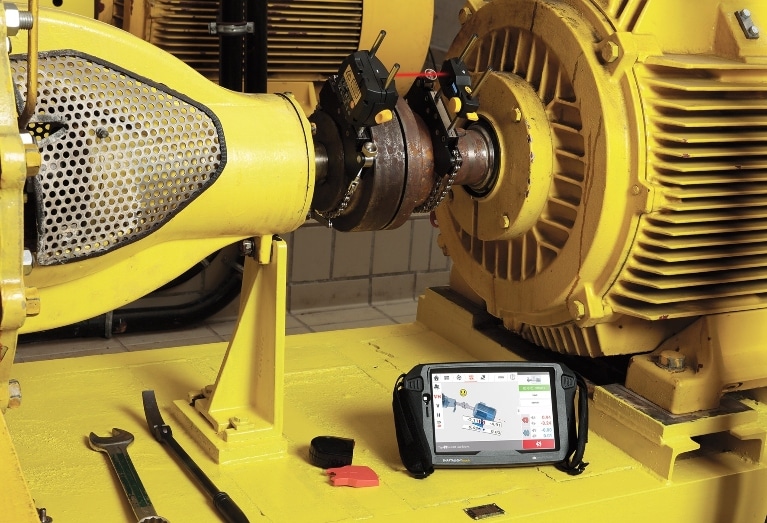Soft foot is a commonly used industry term describing machine frame distortion. It often leads to critical asset faults and is the root cause of most misalignment issues. Soft foot can shorten the lives of electric motors, damage pumps and gearboxes, bend shafts, and cause bearing failure. Over time, soft foot can take assets offline, causing expensive downtime and sending maintenance costs skyrocketing.
It’s estimated that two-thirds of all rotating machinery have soft foot conditions. Repairing those conditions transforms plant operations, improving efficiency and lowering costs. But all too often, soft foot is overlooked.
This article will explain exactly how you can diagnose soft foot reliably and quickly. We’ll talk about the different types of soft foot and explain how to identify and repair them. We’ll also discuss how correcting soft foot will benefit your whole plant. Finally, we’ll explain how to choose the right tools for the job so you can fix soft foot and get back to work.
What is Soft Foot?
Soft foot is an umbrella term. There are a few different kinds of soft foot, and each type needs to be approached in a different way. In simple terms, soft foot means any condition where a machine is not evenly supported by all of its feet; typically this means that one or more of the machine’s feet are not making good contact with the base. Soft foot creates improper contact between the machine and its base and gradually warps the machine, causing a range of related issues.
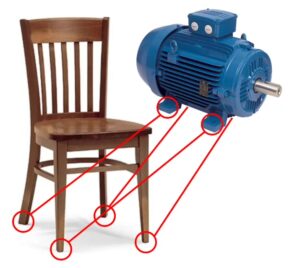
An easy way to visualize soft foot is to imagine a four-legged wooden chair that wobbles because one leg is shorter than the others, or because dirt and debris have built up on the floor under one of the chair legs. Similarly, if all of the foot points on a machine base aren’t entirely even, the machine will wobble. To correct the condition, you must adjust all of the foot points and the entire machine frame to achieve precise alignment.
Soft foot is one of the most overlooked conditions at most plants. Teams miss the problem because it’s hard to spot, especially for inexperienced crews. Pinpointing soft foot can be a long, slow process, and it’s easy to lose patience. Fortunately, using the right tools can speed up the diagnostic process and make repairs much easier, improving operational efficiency throughout your plant and reducing the long-term costs of maintenance.
Why Is Soft Foot a Problem?
Soft foot complicates the alignment process, making it much harder to get repeatable measurements and correct misalignment. Even a minimal wobble causes the machine to stand slightly differently each time crews attempt to align it. Each set of measurements will be different, dramatically slowing down the adjustment process.
Soft foot causes strain on the machine casing and increases the load on bearings once the machine is bolted down. Left uncorrected, soft foot leads to misaligned shafts and bearings, pump and gearbox issues, seal failure, and bent shafts.
Over time, all of these conditions can lead to equipment failure. Even before an asset breaks down, soft foot can cause increased energy consumption, corrosion, and cracks in the machine casing.
Unfortunately, soft foot is usually not as obvious as a wobbly chair: it can be so subtle that you can’t see it or feel soft foot. That’s why it’s so important to inspect equipment regularly. Teams should check for soft foot during the installation process, and then again every time they realign assets. Even seemingly minor soft foot — like a machine being unbalanced by a few millimeters — can cascade into a major issue.
What Are the Four Types of Soft Foot?
There are four types of soft foot: parallel soft foot, angular soft foot, squishy foot, and external force soft foot. Here’s an explanation of each condition.
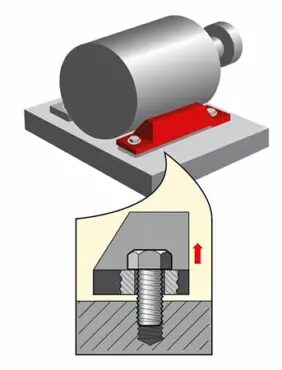
1. Parallel Soft Foot
Parallel soft foot is the most common type of soft foot and typically the easiest to detect. It happens when a machine foot doesn’t reach the base and creates a gap between the foot and the frame. As the gap begins to close with each tightening of the bolts, the machine frame starts to bend to fit the baseplate, causing misalignment. You can usually correct the problem by using shims, as long as they are the appropriate thickness and you don’t use too many.
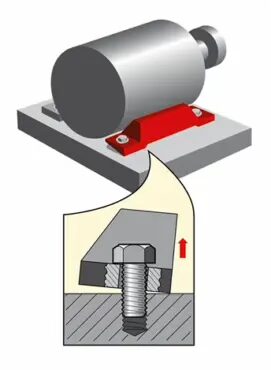
2. Angular Soft Foot
Angular soft foot happens when a machine foot touches the base on either the side or outside of the foot. Because the other side of the foot is bent away, an angle is created between the base and the bottom of the foot. Angular soft foot is harder to diagnose because it occurs at an angle.
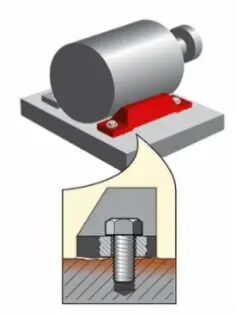
3. Squishy Foot
When too many shims have been used to try to correct a soft foot problem, squishy foot is the result. It can also happen when an excessive amount of corrosion or debris builds up under the machine foot. It’s a frequent problem, especially if the machine’s bolts haven’t been tightened for a long time or if the machinery has been operating continuously and has rarely, if ever, had the bolts loosened.
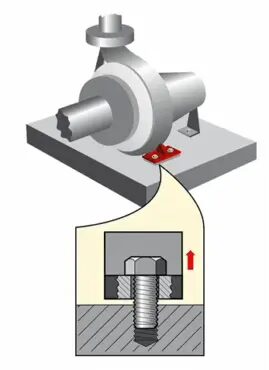
4. External Force Soft Foot
External force is a soft foot condition caused by stress-induced external forces such as pipe strain, electrical connections, or severe misalignment combined with a stiff coupling. It can be hard to diagnose and can happen at any time during machine alignment.
What Are the Causes of Soft Foot?
Soft foot is caused by warping, damaging, or twisting of a machine’s feet or its casing. The condition can also be caused by damaged or warped machine baseplates. Likewise, a build-up of debris, paint, or even excess shims under a machine’s feet can cause soft foot (to be more specific, that build-up can cause squishy foot).
What about root causes? A number of different situations can cause machine feet and bases to warp, leading to soft foot conditions. Here are a few:
Excess Shims Under Machine Feet
As a rule of thumb, you should not place more than three — or at most four — shims under each machine foot. Too many shims can lift one part of the machine base too high, distorting the machine frame.
Too many shims can also create squishy foot. Another tip for preventing squishy foot is to alternate between shims of different thicknesses.
Improperly Machined Feet or Machine Base
Poor machining can lead to soft foot conditions by creating surfaces that are too uneven and do not allow the machine feet to rest evenly on the base.
Bent or Damaged Shims
It’s important to use the right shims for the job, and not to use too many. Regular inspections should also take place to ensure that shims are in good condition. Bent or damaged shims can prevent the machine from making solid contact with the base, creating soft foot.
Improperly Placed Support Pads
If the support pads placed under machine feet are angled, they can cause the frame to distort. The distortion normally occurs while the machine is being bolted down into place.
Pipe Strain
Pipe strain can put extreme stress on a machine frame. The resulting pulling, twisting, and distortion of the machine frame can sometimes create a soft foot condition.
External Stressors
Pipe strain is one of the most common causes of soft foot, but other external stressors can cause the condition.
Severe misalignment can warp the machine frame or feet, leading to soft foot. In some cases, electrical issues can create a soft foot condition. In other cases, extreme weather conditions can cause machine frames to crack or distort, leading to soft foot. And of course, human error — including dropping or mishandling machines — can cause damage and distortion that creates soft foot.
How to Fix and Minimize Soft Foot
Several techniques exist to diagnose soft foot, but accurate measurement comes down to the right tools. Here are the devices you need to test for soft foot and eliminate any debris found under and around the feet to ensure proper alignment.
- Feeler gauge: A feeler gauge is used to measure gap widths or the clearance between two parts. The tool has several steel blades with different thicknesses that can measure as little as 1/1000 of an inch or up to a quarter (¼) inch.
- Micrometer or digital caliper: A micrometer can also measure gap thickness. The tool is used to verify shim thickness. A caliper is used to measure shim stacks before inserting them under the feet. This verifies that the shims are the thickness as labeled by the manufacturer and not defective.
- Wire brush: This tool clears away the debris or corrosion you may come across while checking machinery feet.
- Cleaner/degreaser: Use a heavy-duty degreaser in combination with the wire brush to clean existing shims and contact surfaces during soft foot correction. Brake cleaner works well, but you might also have success with other well-known commercial cleaners.
- Laser shaft alignment system: A laser system can be helpful when measuring for soft foot and is easy to use. This sophisticated tool walks you through the measurement process via a series of screens and includes an auto-diagnosis. Although you can use either a dual or single laser shaft alignment tool, a dual system can be more challenging to use.
Laser alignment tools are designed to be intuitive and easy to learn. They have a built-in soft foot function so that diagnosing the condition is straightforward. Even new team members or employees with no technical background can learn to use the tool with minimal training. This makes it easier to do routine checks for soft foot.
Correcting Soft Foot With Shims
Using shims to correct machine foot issues is usually very effective. However, if the frame or mount is bent, twisted, or cracked, or other overall machinery destruction has occurred, correcting the condition can be quite tricky.
In most cases, the machine you’ll be working on will already be shimmed. It’s a good practice to clean any shims that are not new and also clean the base plates and feet to eliminate any dirt and debris. If you do not remove the corrosion, paint, and grime that can accumulate over time, squishy foot can occur during alignment.
5 Rules to Avoid Squishy Foot
Here are some good rules of thumb to follow to better ensure that you don’t create a squishy foot condition while trying to eliminate another soft foot condition.
- Use shims big enough to cover at least 80% of the footprint. Shims come in many sizes, and if the machinery requires large shims, they’re usually fabricated on-site.
- Apply no more than four shims under each foot. If you add too many shims, you risk producing a spring-like situation, which defines squishy foot.
- Sandwich thin shims in between thick shims. It makes placement easier and eliminates the potential for shim creasing.
- Measure stacks with a micrometer to verify shim thickness. Use it to make sure things add up as they should because errors or defects sometimes happen during manufacturing.
- Measure shims over 0.030 inches to verify thickness. Some sources might recommend lower or higher thicknesses, but ultimately, it’s your decision.
By following these soft foot best practices, including applying the right methods and tools to accurately diagnose and correct the condition, you set yourself up for success. Always remember to check for soft foot before aligning shafts. It will save you time, money, and headaches.
Why Laser Alignment Tools Are Key to Fixing Soft Foot
Laser alignment tools are a game changer when it comes to diagnosing and correcting soft foot. They’re precise, accurate, and reliable and make the process easy enough to become a regular part of your maintenance routine.
It’s worth repeating that roughly two-thirds of all rotating assets have a soft foot condition. Over time, that can lead to premature wear and tear, excess fuel use, corrosion, and a range of other issues. All these problems can cause machine failure, resulting in expensive downtime and production delays.
In order to stay ahead of soft foot issues, technicians should inspect each machine foot every time they install or realign assets. In the short term, checking for soft foot will result in more accurate, repeatable alignment measurements, making the process more reliable. In the long term, checking for soft foot will prevent potentially serious issues. Fortunately, using laser alignment tools helps simplify this process.
The best laser alignment tools come with a built-in soft foot function. During the soft foot check, the technician loosens the bolts one by one and uses the device on one foot at a time. The laser alignment tool measures machine movements and calculates how much each foot moves as the bolts are loosened.
Today’s top-of-the-line laser alignment devices are precise enough to capture even minor movements that point to soft foot. Some systems can also automatically analyze those measurements and tell technicians exactly what kind of shims to place under the feet in order to correct the soft foot condition.
With the right tools, misalignment issues are easier than ever to spot and correct, and teams can stay ahead of the critical conditions that soft foot creates. Contact Pruftechnik for more information on cutting-edge alignment tools for any application.

